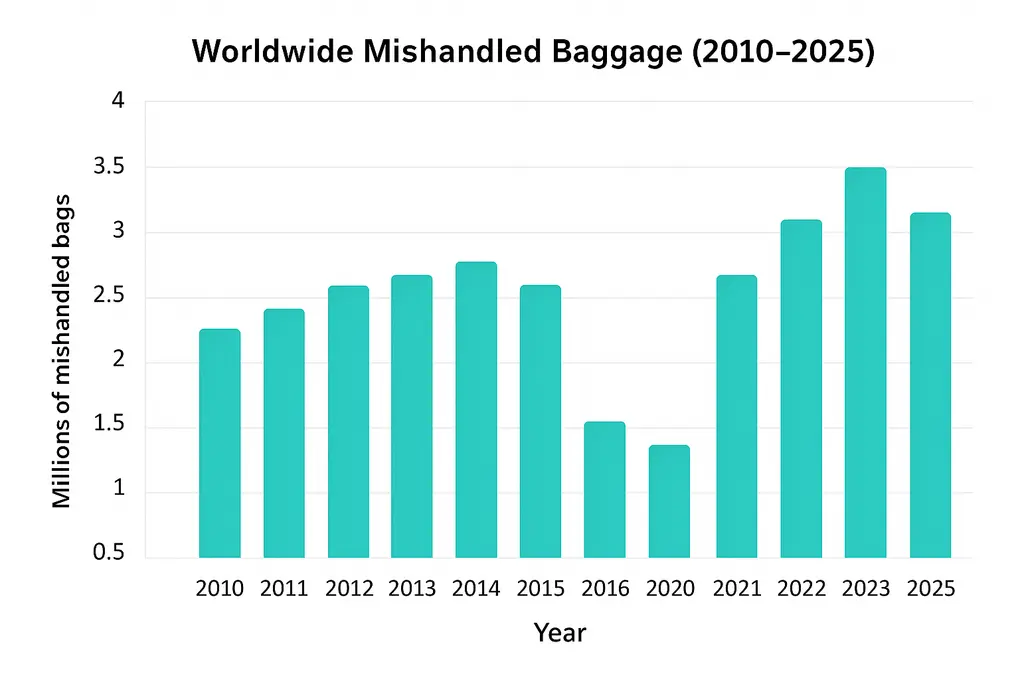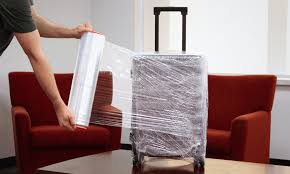I have traveled internationally for years and also worked with luggage brands, so I know how tempting a shiny bag can be to a thief. I often recall stories like the traveler who tracked her stolen suitcase with an AirTag, her tale reminds me that an opportunist can walk off with luggage at a busy baggage claim.
Global data show roughly one in twenty bags is lost or stolen each year, about 2 million pieces of luggage worldwide lost each year. That means it’s worth taking precautions seriously to protect your luggage from theft. Below, I cover how to prevent luggage theft at airport, train, and lodging tips to keep your bags safe on every leg of your journey.
How Many Luggages are Lost Worldwide:
In Covid-19 times because of less travel so the lost or theft rate in those years is lowest as you can see in the graph. this data only coovers the lost or theft luggage it has not included mishandled luggage. Their are almost more then 2 million luggages, lost or stolen each year. So it is important to look for safety before buying luggage.

Choose Anti-Theft Luggage and Gear:
Your first line of defense is the right bag and accessories. Opt for backpacks and suitcases with built-in anti-theft features: look for slash-resistant fabric, cut-proof straps, lockable zipper pulls, and hidden pockets. Many anti-theft bags have reinforced panels and double-locking zippers on all main compartments. I also pack a few gadgets:
- Cable locks and padlocks: Use a TSA-approved padlock on checked bags (TSA has the master key). I also carry a small cable lock or two, I wrap them through handles and loop them around a pole or fixture when I need extra security.
- Portable travel safe: A Pacsafe-style mesh pouch with a built-in cable that you loop around a pipe or heavy furniture. I fill mine with passports, my camera and extra cash before leaving a hotel room. Thieves rarely bother cutting into a locked safe.
- Bright luggage straps or ribbons: A colorful locking strap around a checked bag makes it easy to identify and harder to steal. Travel guides even suggest tying a neon ribbon on your handle, most thieves will skip a bag that stands out.
- Tracking devices: Slip an AirTag or Tile tracker in each bag. That viral AirTag story shows their value: you may be able to locate a stolen bag in real time.
Personally, I use a slash-proof anti-theft daypack with lockable zippers for my carry-on, it’s worth the investment.
At Airports and on Flights:
Airports are high-risk areas.
The Rule that I also follow is to keep your valuables with you. Never pack electronics, jewelry or large sums of cash in checked luggage. Instead, carry them in a daypack or on your person. If I do check a suitcase, I also pack a change of clothes and a few toiletries in my carry-on, just in case. I always put a bright luggage strap or ribbon on my checked bag (as above) so it stands out.
When checking bags, lock them with a TSA-approved padlock, but stay aware. TSA can open those locks, and any determined thief could cut a flimsy lock. Double-check that your bag zippers are fully closed after screening, and consider securing zipper pulls with a small padlock or cable tie for extra security. Slide a business card or copy of your boarding pass inside your bag, if someone honest finds it, they’ll know how to return it. Keep your carry-on in sight at all times during check-in and at the gate, and stow it near your seat on the plane.
After landing, go straight to baggage claim. If a bag is missing, report it immediately to the airline’s desk and file a claim. With these precautions, thieves are less likely to target your checked bags in the first place. Use the photos of your packed items as evidence and check if travel insurance or credit-card insurance covers lost/stolen luggage.
Wrapping your suitcase in plastic film is a simple yet effective way to deter theft and tampering at airports. While it won’t stop someone from taking the entire bag, it makes it much harder for thieves to open your luggage unnoticed and steal items from inside. The tight layer of stretch film acts as both a security seal and a protective cover, discouraging opportunistic thieves and safeguarding your belongings during baggage handling. Plus, it helps protect your suitcase from scratches, dirt, and rain throughout your journey.

On Trains and Public Transits:
On trains and buses, thieves look for relaxed passengers. Don’t leave bags in empty storage racks. Instead, place your luggage on the overhead rack across from your seat where you can see it. If you plan to sleep or step away, lock or tether your bag with a cable to the rack.
I personally use the Lewis N. Clark Cable Luggage Lock (TSA approved, with a 30-inch retractable steel cable and a set-your-own combination). It’s compact, easy to carry, and strong enough to loop around fixed objects like a train seat, luggage rack, or even a hotel bed frame. The bright green color also makes it easy to spot on your bag, which can be an extra theft deterrent.
Other safety tips:
- Buddy system: If you’re traveling with friends or family, take turns staying awake or watching the bags. If you sleep in a shared compartment, try to have someone keep watch.
- Beware distraction scams: Thieves may pose as fellow passengers asking questions or offering help to divert you, while an accomplice grabs your bag. Always be alert.
- Lock compartments, use top bunks: If sleeping in a sleeper car, lock the cabin door and use the upper berth if possible, top bunks are harder for thieves to reach.
- Keep valuables hidden: Carry wallets, passports and phones on your person or in an inner pocket. Never leave them on a seat or open bag where someone nearby could slip them away.
- Loop it around you: When seated or napping, fasten your bag by looping a strap around your leg or arm. Rick Steves notes even a twist-tie can slow a thief down. Even a minor obstacle makes it much harder to snatch your bag.
In short: make your bag a harder target. Lock it, chain it, and keep it in sight. A thief will move on if a bag looks difficult to take.
In Your Hotel or Hostel
Accommodations should feel secure, but you still need to be cautious. In hotels, use the in-room safe for valuables if it fits, or lock your suitcase to a heavy piece of furniture. If you’re in a hostel or budget stay, pack your most important items in a portable safe pouch and lock it to something fixed in the room. I know a traveler who does this with her passport, camera and hard drives, and she says she has never had anything stolen from her room since.
When I lived in a hostel during my student days, keeping my valuables safe was always a worry. I had my laptop, some cash, and important documents, but the shared living space meant I couldn’t leave them lying around. That’s when I started using the Pacsafe Travelsafe X15, its portable lockbox design and steel mesh protection gave me peace of mind knowing my belongings were secure, even when I wasn’t in the room.
In any accommodation: never leave valuables unattended. Don’t sit down at a café or lounge with your laptop open on the table, and don’t walk out of your room with phones or wallets on the nightstand. In hostels, always lock the dorm locker (bring a sturdy padlock). If there is no safe available, simply locking your valuables in your luggage is a very effective alternative. A locked door and a locked bag are usually enough to scare off casual thieves.
Final Tips:
Before you travel, document your belongings. Take photos of everything you pack, clothing, gear, shoes, and note any serial numbers. Those images become crucial evidence if you need to file an insurance claim. Also, think like a thief: don’t show off expensive luggage or gadgets. Many travelers use plain or older bags and even wrap checked bags in clear plastic to add a tamper-evident layer.
If the worst happens and luggage is stolen, act quickly. Report it immediately to airport or police authorities and file a detailed claim with your airline. Include the photos and receipts if you have them. Check what protection you have: travel insurance or credit-card benefits may reimburse you. Finally, even for shipments or cargo, use a sturdy lock and tracking, this helps prevent cargo theft. By staying alert, using the right locks, and keeping records, you make theft much less likely. Travel safe and enjoy your trip with confidence.




